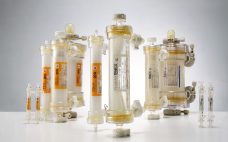This webinar features: Esha Vyas, Field Applications Manager, Asahi Kasei Bioprocess America Virus filtration is a critical unit operation in the manufacture of biotherapeutic products. Rigorous and careful validation of this process-dependent step is necessary to demonstrate that the selected virus filter meets regulatory requirements. Thoughtful design and implementation of spiking studies are imperative to successful validation, and these studies may include consideration of various robustness and process parameters. Overall, the study design should be conducted as a representative scaled-down…
Webinars
Planova BioEX: Leading the Next Generation of Virus Filters
This webcast features: Daniel Strauss, PhD, Principal Scientist, Research and Development group at Asahi Kasei Bioprocess America Virus filtration is a critical unit operation in the manufacture of biotherapeutic products owing to its capability to remove a broad range of viruses. Selection of virus removal filters based on filterability and virus removal performance over a range of process conditions ensures predictable processes. The Planova™ BioEX filter shows high flux with minimal flux decay for some of the most challenging products…
Evaluation of the “Scale-Out” Biomanufacturing Strategy from Early Clinical Stage to Commercialization
This webcast features: Jie Chen, MD, MS, Vice President of CMC Management, WuXi Biologics The success of therapeutic biologics over the past decades has reshaped the pharmaceutical industry landscape. From orphan to biosimilar to novel blockbuster drugs, the production demands can range from grams to metric tons of biopharmaceutical products each year. This diverse range in manufacturing scale coupled with thousands of biologics in the development pipeline, has had significant impact on the design of biologics production models. Without…
A Novel Approach to Single-Use Design and Implementation
This webcast features: Graeme Proctor, Product Manager, Single Use Technologies, Parker Hannifin Manufacturing Ltd Single use assemblies can frequently take in excess of 16 weeks from concept to customer delivery. Challenges around design, customisation, validation and qualification can create delays in implementation and increase time to market. Parker will present a novel approach to single use design and implementation, which can dramatically reduce lead times and increase delivery reliability without affecting flexibility or quality. Learn how to: Quickly and easily…
Targeted Locus Amplification for Transgene Sequencing in rCHO Clones Expressing Therapeutic Lysosomal Enzyme
This webcast features: Vishal Agrawal, PhD, Scientist II, Cell and Molecular Biology, Biomarin Pharmaceutical Inc. and Joseph Abad, Field Applications Scientist, MaxCyte. Transgene site of integration dictates clonal stability and the long term transcriptional activity of gene of interest in recombinant CHO cells. In this presentation, we will discuss the application of targeted locus amplification (TLA) technology to identify genomic sites of transgene integration and integrity of transgene sequence itself to assess the suitability of recombinant CHO clones as a…
Single-Use Bag Permeability Testing in Cryopreservation Conditions
This webcast features: Mike Johnson, Business Development Engineering Manager, Life Sciences Puncture strength, haze, Tg, extracts and permeation rates are all single-use bag attributes about which end-users want data. While these are important characteristics, they are polymeric material properties that may or may not indicate actual bag performance. Ultimately, an end-user wants to know that the single-use bag will not put their process fluid at risk. In this study, single-use bags with different gas permeation rates were filled with a…
Purification of Antibody Fragments with Amsphere™ A3 Protein A Resin
This webcast features: Gerald Platteau, Application Development Engineer, JSR Life sciences Purification of full-length antibodies containing an Fc region relies on Protein A affinity chromatography as the golden standard capture step. The well-known robustness, high selectivity and scalability make it an ideal platform technique, minimizing downstream processing development time to bring new antibodies to market. After monoclonal antibodies (mAbs), various forms of antibody fragments are now becoming the next most important class of protein based therapeutics. These antibody fragments offer…
CHT Column Packing is Easier
Than You Think
This webcast features: Dr. Mark Snyder, Manager, R&D Applications, Process Chromatography, Bio-Rad Laboratories This webcast presents best practices and guidelines for packing CHT™ Ceramic Hydroxyapatite Media at process scale. CHT, is an easy-to-use mixed-mode chromatography media. It offers cation exchange and affinity interactions. Unlike other chromatography media, CHT is both the ligand and the support matrix. It is used for the purification of numerous types of biomolecules and is considered the gold standard for aggregate removal. This webcast highlight CHT…
Single-Use Powder Containment Solution
This webcast features: David Howes, ILC Dover Learn about modern single-use powder containment best practices and how to reduce cross contamination and airborne particulates.  You will gain insight on how you can increase safety and speed when handling powders. In the study, we will discuss the ease of fill along with dispensing times and product loss. ILC Dover’s EZBiopac® shows a 71% decrease in filling times when measured against an industry standard 2D bag. Due to the non-static film we…
Proper Task Performance in GMP BioManufacturing: Human Error Reductions
This webcast features: Tony Fultz, Director of Upstream Manufacturing at Fujifilm Diosynth Biotechnologies. Human error reduction should be a top priority of every organization. Our company, clients, and most importantly, our patients are heavily dependent on right first time execution. Human error is, and will likely always be, the highest contributor to deviations and batch failures. Fujifilm Diosynth Biotechnology (FDB) is aggressively seeking to reduce human error. Using his experience in the nuclear industry, Tony Fultz shares a method implemented…










